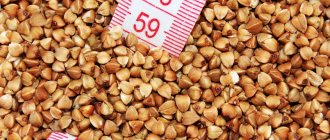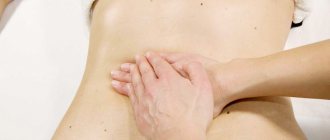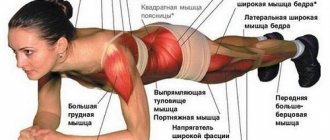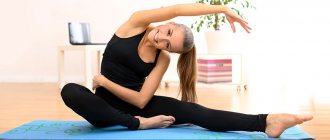A sedentary lifestyle, unhealthy diet, lack of exercise, and high levels of stress lead to flabby bellies.
The larger the belly, the higher the risk level. A proper diet, combined with a good workout, will help reduce your belly fat and define your waist.
These poses not only get rid of abdominal fat, but also allow you to control your body and mind.
Tadasana (Mountain Pose)
Tadasna is an ideal warm-up pose. Improves blood circulation, ensuring the body is ready for practice.
How to do
Stand tall with your legs straight, heels slightly apart and your big toes remaining in contact with each other. Keep your spine straight, arms on both sides with palms closer to your body. Extend your arms forward and bring your palms close to each other.
Inhaling deeply, stretch your spine. Raise your folded arms above your head and stretch as far as you can. Try standing up on your tiptoes, looking up at the ceiling. If you can't stand on your toes, lower your heels to the floor and lift your face towards the ceiling. Breathe normally and hold the pose for 20 to 30 seconds.
Inhale deeply, and as you exhale, slowly relax and lower your feet to the floor.
Repeat the asana 10 times, gradually increasing the time spent in the pose. Rest 10 seconds before attempting the next rep.
Benefit
Improves posture, the shape of the abdomen and buttocks. Strengthens hips, knees and ankles.
Relieves sciatica (pain that affects the back, hips and outer legs).
Contraindications
People suffering from low blood pressure, insomnia, headaches are not recommended to perform this pose.
Tips for beginners
Yoga exercises for the abdomen, in addition to the required level of muscle stretching, require mastery of breathing techniques. Moderation and increasing the proportion of fresh plant foods in the diet is another condition for successful exercise.

When practicing, you must adhere to the following rules:
- Pay attention to contraindications and consult a doctor when selecting a set of asanas. As a rule, their implementation is not recommended during pregnancy, acute stages of diseases of the internal organs and spine;
- Exercise daily, without skipping;
- Start exercising on an empty stomach, at least 3 hours after eating;
- Drink 1-1.5 liters of water per day;
- Do a warm-up with simple exercises to warm up your muscles;
- Perform exercises in your comfort zone, avoiding pain and dizziness;
- Start practice with 5-10 minutes, gradually increasing repetitions and learning new types of asanas;
- Repeat each pose from 3 to 5 times, with short (up to a minute) breaks;
Surya Namaskar (Sun Salutation)
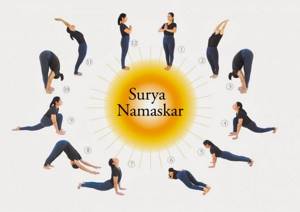
Surya Namaskar is a fusion of twelve yoga positions, each of which has a significant impact on the entire body. Performing deep breathing while performing asanas will help in detoxifying the body. Practicing Surya Namaskar daily in the morning, facing the sun, brings a sunny mood and joy.
How to do
Keep your feet together, open your chest and relax your shoulders. As you inhale, raise both arms to the sides. As you exhale, bring your hands to the front of your chest and clasp them in prayer. Inhale, raise your arms, and bend at the chest. Exhale, bend forward and try to touch your forehead to your knees. Bend your left knee, step your right leg back, place your palms on the floor. Hold your breath, then move your left leg and left leg. This is called plank pose. Bend toward the floor, keeping your spine up and your knees, chest, and chin in contact with the floor.
Inhale, reach forward and arch your chest into upward-facing dog pose. Keep your hands on the floor, exhale and lean forward, lifting your tailbone and pelvis up. Inhale and bring your right leg forward, between your elbows, and stretch up. Bring your left leg forward and inhale deeply. Stretch upside down, feel the stretch in the back of your thighs and how your spine stretches. Return to the starting position.
Benefit
From head to toe, all parts of the body, and internal organs benefit from the practice of surya. Regular practice of Surya helps you stay healthy and energetic.
Contraindications
Women should not perform Surya Namaskar during menstruation. Pregnant women should consult their doctor before practicing. People with spinal problems, high blood pressure, cardiovascular diseases, insomnia and headaches should refrain from practicing.
Padahastasana (Forward Bend)

How to do
Stand in Tadasana with your arms on either side of your body, feet together, and heels touching each other. Keep your spine straight. Inhaling deeply, raise your arms up. As you exhale, bend forward so that your body is parallel to the floor. Inhale, exhale and bend forward completely. Try to touch the floor with your toes on the floor without bending your knees. Hold your breath, suck in your stomach, and hold the position for 60-90 seconds. Exhale and slowly return to Tadasana. Repeat the asana 10 times, with an interval of 10 seconds between repetitions.
Benefit
Improves digestion, maintains abdominal muscles in tone. Strengthens joints. Relieves mental and physical stress.
Contraindications
Before performing Padahastasana, you need to master Uttanasana, which is less difficult. Additionally, people with spinal disc problems should refrain from performing this pose.
Side plank (Vasishthasana variation)

The side plank tones the obliques. Removes fat deposits from the sides.
Place your forearm parallel to the top of your mat. Spread your fingers to the sides. Either bend your lower leg at the knee or distribute your weight between your forearm and the side of your foot. Tighten your buttocks and suck in your stomach. Inhale and point your top arm toward the ceiling. Exhale and bring your shoulder blades together. Keep your neck soft, and look forward. If there is no tension in your neck, challenge your balance and look up at your arm. For an added challenge, bend your top leg and point your knee up.
Paschimottansana (Seated Forward Bend)
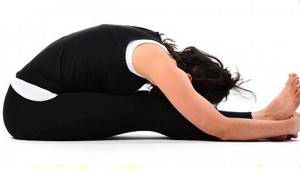
This is one of the main poses of Hatha Yoga, which stimulates the solar plexus center. Along with its toning effect on the tummy, the forward bend also offers a delightful stretch to the hamstrings, joints, and hips. It is also ideal for those who are prone to digestive disorders.
How to do
Sit on the floor in Sukhasana. Keep your spine straight and spread your legs across the floor. Toes point to the ceiling. Inhaling deeply, extend your arms above your head without bending your elbows. The gaze should follow the hands. Stretch your spine to the maximum. Exhale and bend forward from the hips. Bring your arms forward and try to touch your toes. The head should rest on your knees. Beginners can try touching their ankles or just their thighs to start. Once you touch your toes, try to hold them by pulling back, this will stretch your hamstrings. As you inhale, hold your stomach and try to maintain the starting position for 60 to 90 seconds. Slowly, increase the time you hold the position for five minutes, or more if possible.
Exhaling, stretch your body up, releasing your fingers, and return to Sukhasana.
To begin with, repeat the asana 10 times, then work up to 25 or more times.
Benefit
Relieves stress. Helps in reducing abdominal fat. Balances menstrual cycles.
Contraindications
People who have spinal disc diseases should not perform this pose. For asthma and diarrhea, the same applies.
Pavamuktasana (Wind Release Pose)
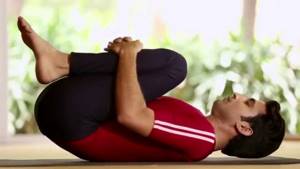
This asana helps in combating various gastric problems including indigestion and constipation.
How to do
Lie in a supine position (face up) with your arms next to your body, legs extended straight, and heels touching each other. Bend your knees. Take a deep breath, and as you exhale, gradually bring your bent knees to your chest, pressing your hips into your stomach. Keep your knees together while pressing your hands onto your thighs. Inhale again, and as you exhale, lift your head, this will allow your chin to touch your knees.
Hold the position for 60 to 90 seconds, while breathing deeply. Exhale slowly and release your knees, allowing your head to rest on the floor. Bring your arms to either side of your body, palms on the ground.
Relax in Shavasana. Repeat the asana 7 to 10 times, with a 15-second interval between repetitions.
Benefits
Strengthens the back and abdominal muscles. Helps in digestion and release of gas. Tones the muscles of the legs and arms.
Contraindications
Pregnant women, people suffering from spinal problems, people with high blood pressure and heart problems should refrain from performing this pose.
Plank
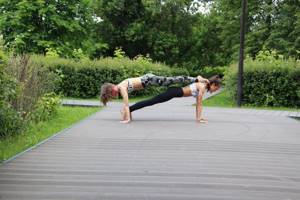
Tones the arms, shoulders, and abdominal muscles. The muscles of the shoulder region are strengthened.
Hands shoulder-width apart, knees hip-width apart, and fingers spread wide apart. In the plank, we actively work with our hands, trying to mentally pull the mat towards ourselves. The legs are actively working, the kneecaps are pulled up, and the heels are heading towards the mat. The neck remains soft, the gaze is directed to the floor.
Nauksana (Boat Pose)
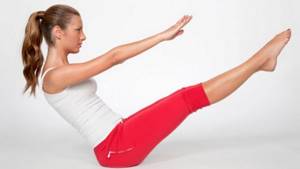
This is one of the most sought after yoga poses that will guarantee you a flat tummy! Holding the pose for more than a minute, the abdominal muscles contract, leaving the pose has a tonic effect on the abs.
How to do
Lie on a yoga mat in a supine position with your legs extended, toes pointing toward the ceiling, and palms facing the ground on either side of your body. Take a deep breath. As you exhale, lift your body (head, chest, and legs) off the ground. Extend your arms so that they form a parallel line with your legs. The fingers should be in line with the toes. As you hold the position, feel your abdominal muscles contract. Breathe evenly and maintain your posture for 30 to 60 seconds. Inhale and then exhale deeply, slowly relax and return to the supine position. Repeat this asana five times to begin with, gradually increasing the work up to 30 times. Rest 15 seconds after each repetition.
Benefits
Strengthens the abdominal muscles and helps remove belly fat. Improves digestive health. Strengthens arms, hips and shoulders.
Contraindications
People suffering from blood pressure problems, heart problems, diarrhea, headache, insomnia should refrain from performing this pose. Also, pregnant and menstruating women should not practice this pose.
Important Tips
To make the training as effective as possible, adhere to the following rules:
- Before classes, ventilate the room or hall.
- They train either in the morning or in the evening.
- During exercises, breathing is done through the nose.
- You should not eat food before classes. At least 2-3 hours should pass from the moment you approach the table.
By doing yoga, you can quickly and effectively get rid of excess weight, work out your abdominal muscles and trim your sides. For training to bring only health benefits, you need to do the exercises correctly. Therefore, it is better to master yoga under the guidance of a professional.
Ushtrasana (Camel Pose)

It is usually done after Boat Pose. The tension you feel as you lean back and touch your ankles has a tonic effect on your abdominal muscles. The tension experienced by the abdominal muscles during Boat Pose goes away, and at the same time the pleasure of a good stretch appears.
How to do
Sit in Vajrasana. Slowly raise your body from your knees. The heels form a perpendicular line with the ground. Exhale deeply and arch your back. Reach your arms back and try to grab your ankles, one after the other. Tilt your head back and stretch in the opposite direction, feeling the stretch across your entire abdomen and thighs. To begin, hold the pose for 20 to 30 seconds, then stretch to 60, breathing normally. Exhale and slowly relax. Return to Vajrasana. At the initial stage, repeat this asana five times, gradually increasing the number of times to 30 gradually. Rest 15 seconds after each repetition.
Benefits
Strengthens the back muscles. Improves posture. Treats fatigue, menstrual discomfort and relieves back pain.
Contraindications
People who suffer from diseases related to the heart, lower back or neck injury, or have high blood pressure should not perform this pose. Persons who suffer from migraines and insomnia should also refrain from performing this pose.
Utanpadasana (Leg Raising Pose)
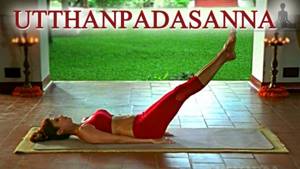
This pose helps to get rid of the problem area of the lower abdomen and also strengthens the thighs. This pose is one of the most effective and efficient, thanks to it flabby muscles and accumulated deposits around the waist and hips gain elasticity and strength.
How to do
Lie on the mat with your back on the floor, legs extended. The heels touch each other. Keep your arms on either side of your body, with your palms facing the ground. Take a deep breath. Do not move your hands from their original position. Breathe normally. Stretch on the floor to the maximum possible level without arching your lower back. Inhaling deeply, lift your legs off the floor and keep them at a 45-degree angle to the floor. Hold the pose for 15 to 30 seconds, breathing normally. Work slowly to maintain the posture for more than 60 seconds. Exhale deeply and lift your legs so that they are at a 90-degree angle to the floor. Breathe and hold the pose for about 30 seconds. Inhaling deeply, gradually bring your legs back to the starting position - lying on your back. To begin, repeat this asana 10 times, gradually increasing to 30. Rest for 15 seconds after each repetition.
Benefit
Treats the stomach and related ailments, such as high acidity and constipation. Treats back pain. Improves the functioning of the reproductive organs. Improves blood circulation.
Contraindications
When recovering from spinal injuries, this pose should be avoided.
Video yoga lessons for beginners
Yoga classes with Denise Austin
Denise Austin is a popular American fitness television host. Thanks to her rich sports experience, she was able to create a series of exercises aimed at weight correction. Denise herself, who has long since passed the 50-year mark, emphasizes the benefits of the program with her appearance. The uniqueness of her technique lies in the limited selection of simple exercises that have the maximum impact on the body. Regular implementation of the complex 2 - 3 times a week helps to quickly lose weight. But its most important feature is considered to be assistance in maintaining the achieved results.
Jillian Michaels yoga for weight loss: 1 course
Yoga from Jillian Michaels is not yoga in the classical sense; it can rather be called power yoga. The course consists of 2 levels, lasting about 30 minutes. This course is good because by practicing it, you can significantly improve your stretching and coordination of movements (this is for those who have problems with balance), which in turn will have a positive effect on the quality of performing more difficult exercises from other programs. But this does not mean at all that with its help you will get rid of excess fat. Gillian's training is as effective as always.
Since the lesson time for the first level is not indicated, you can determine it for yourself. For example, when you feel that performing the first level exercises no longer causes you much difficulty.
For a yoga class with Jillian Michaels, all you need is a yoga mat and you're good to go! Good luck.
VIDEO
Tatyana Myskina yoga for obese women
It is common for a woman at any age to dream of a beautiful, healthy body, good posture, and an easy gait. Or maybe you want to get rid of the pain that tormented you throughout your body, and always have a great mood, be active and energetic. We recommend to your attention the video lessons “Yoga for plus-size people with Tatyana Myskina.” By regularly performing the exercises proposed by Tatyana Myskina, you will become healthy, cheerful and strengthen your body, giving it flexibility and elasticity. The program contains exercises aimed at working the upper body, thighs, buttocks, legs, and waist. This complex is ideal for self-study at home, after which you will feel an incredible surge of strength, energy, and a wonderful mood is guaranteed.
Marjariasana (Cat Pose)

In addition to reducing belly fat, this pose increases the flexibility of the spine.
How to do
Sit in Vajrasana. Breathe evenly and, as you rise from this position, allow your body to stand parallel to the floor so that your body rests on your knees and palms. Your knees should be placed under your hips and your palms should be under your shoulders, facing the floor. Keep your head straight. Stand so that your weight is distributed evenly.
Inhaling deeply, lift your head, stretching your back down so that your body becomes concave. Hold your breath and maintain your posture for approximately 15 to 30 seconds. Exhale deeply and lower your head while arching your back upward. Keep your buttocks and abdomen tense as you contract. The head should be between the hands. Breathing deeply, hold the pose for approximately 15 to 30 seconds, gradually increasing the time you hold the pose to 90 seconds. Exhale and slowly return to Vajrasana. Rest for 15 seconds. Repeat this asana 10 times, gradually work up to 30 times. Rest 15 seconds after each repetition.
Benefit
Increases the strength of the spinal column. Helps correct posture. Relieves tension in the lower back.
Contraindications.
If you suffer from a traumatic brain injury, make sure you keep your head level with your torso when performing this pose.
Bhujangasana (Cobra Pose)

Regular practice of this asana helps in strengthening the back muscles and hence, it is one of the best poses to relieve back pain after childbirth.
How to do
Lie on a mat in a supine position (face down) with your legs slightly extended and your toes touching the floor. Keep your arms on either side of your body, palms facing the floor. Place your palms under your shoulders. Inhaling deeply, slowly lift your chest and head off the floor, fixing your gaze on the ceiling. Stretch from your navel to the top of your head, while keeping your buttocks tight.
Hold the position for 15 to 30 seconds while breathing normally. Make sure you don't injure your back in the process. Hold the pose for 30 to 60 seconds, breathing normally. Exhale and slowly lower your body down - chest, neck and forehead - return to a lying position. Repeat this asana 10 times to start, gradually increasing up to 30 times. Rest 15 seconds after each repetition.
Benefits
Tones the stomach. Increases flexibility in the mid and upper back. Strengthens the shoulders and back. Reduces stress and fatigue.
Contraindications
Bend backwards until you feel a stretch in your abdomen, hips and back. Please rest even if you experience slight pain from the sprain. In such cases, you can do Ardha bhunjangasana.
Additionally, pregnant women, as well as persons suffering from back injuries and carpal tunnel syndrome should not perform this pose.
What's special?
Eastern practice for a flat stomach is characterized by smooth movements and a complete absence of power dynamics. Specially designed
Helps quickly get rid of fat deposits on the sides and abdominal area. With it you can achieve an ideal figure and increase body flexibility.
DETAILS: How to lose weight through exercise: 6 methods from an expert
The main advantages of the technology are as follows:
- The complex in its structure is a health-improving gymnastics, with the help of which all important systems in the body are enriched with nutrients.
- Yoga exercises for losing belly fat activate metabolic processes.
- A gentle cleansing of toxins occurs.
- Excess calories are burned much faster.
- Appetite decreases, weight gradually normalizes.
- The elasticity and plasticity of the body increases.
People begin to practice yoga not only to acquire a thin waist, but also to start leading a healthy lifestyle. Those who regularly perform exercises notice that quitting smoking is much easier, moreover, the nervous system and psyche become more stable, and it is easier to endure stress and nervous shock.
Dhanurasana (Bow Pose)
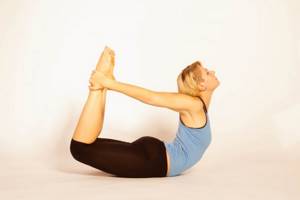
This pose is great for toning the stomach. Along with a good stretch on the abdomen, back, hips, arms, and also chest, this helps in improving posture.
How to do
Lie face down on the mat with your feet together, arms on either side of your body and palms facing the floor. Exhale deeply and bend your knees upward. Raise your head and bend back. Move your arms back and try to grab your ankles with your hands.
Support your body weight with your stomach. Inhaling deeply, try to raise your knees higher.
Hold the pose for 15 to 30 seconds, working gradually from 60 to 90 seconds. Breathe normally, maintain your posture. Exhale and slowly relax, stretching your body. Repeat this asana 10 times, gradually increasing to 30. Rest for 15 seconds after each repetition.
Benefit
Improves posture. Stretches the back muscles and makes them strong. Stimulates the neck and abdomen.
Contraindications
People suffering from high blood pressure, hernia, lower back pain or neck injury should refrain from performing this pose. Pregnant women or women during their menstrual cycle should not perform this pose.
Relax with Shavasana (Dead Body Pose)
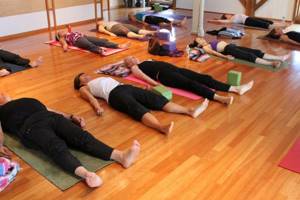
Let your body relax after an intense workout. Dead body pose is an ideal asana for this.
How to do
Lie down in a supine position. Keep your legs together or straight out as you feel comfortable. Let your arms rest on either side of your body. Close your eyes. Inhale and exhale deeply, allowing your body to completely relax.
You must lie down until your breathing becomes normal and your body is completely at peace with itself and with the entire universe.
